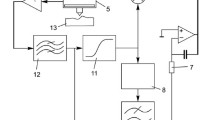Abstract
A recording microindentation instrument equipped with optical observation and acoustic emission detection was built and used to examine, in situ, the crack initiation behavior of a commercial soda-lime-silica based float glass from contact with a Vickers diamond indenter. Indenter motion was provided by a piezoelectric actuator, while a strain gage load cell and capacitance displacement gages simultaneously monitored the indenter load and displacement, respectively, on the glass. It was found that both the maximum load and total indenter contact time influence the initiation behavior. Crack initiation occurred more readily when the total contact time and maximum load were increased. Increasing the maximum load from 0.2 kgf to 4 kgf resulted in the initiation of median-radial cracks on unloading at 6% Fmax up to 50% Fmax, respectively. In contrast, the initiation of lateral cracks was not significantly affected by the total contact time or the maximum load. Examination of the indentation cross-sections beneath 1 and 4 kgf indentation sites revealed well-developed median-radial and lateral crack systems.







Similar content being viewed by others
Notes
Model PZL-60, Burleigh Instruments, Inc., Fishers, New York.
Lebow Model 3189-50, Eaton Corp. Lebow Products, Troy, Michigan.
Model HPT-40, Capacitec Corporation, Ayer, Massachusetts.
Model AT-MIO-16XE-50, National Instruments Corp., Texas.
Physical Acoustics Corporation (PAC), Princeton, New Jersey.
References
Frolich F, Grau P, Grellmann W (1977) Phys Stat Sol (a) 42:79
Loubet JL, Georges JM, Meille G (1986) In: Blau PJ, Lawn BR (eds) Microindentation techniques in materials science and engineering, ASTM STP 889. American Society for Testing and Materials, Philadelphia, PA, pp 72–89
Weiss HJ (1987) Phys Stat Sol (a) 99:491
Cook RF, Pharr GM (1990) J Am Ceram Soc 73(4):787
Frischat GH (1985) In: Kurkjian CR (ed) Strength of inorganic glass. Plenum Press, New York, pp 135–145
Pharr GM, Cook RF (1990) J Mater Res 5(4):847
Wagner CJ (1998) Influence of composition on crack initiation behavior of glasses. M.S. Thesis. Alfred University, Alfred, NY
Lawn BR, Dabbs TP, Fairbanks CJ (1983) J Mater Sci 18(9):2785
Canfield NL (2000) Effects of alkali and alkaline earth additions on the mechanical properties of silicate glasses. M.S. Thesis. Alfred University, Alfred, NY
Doerner MF, Nix WD (1986) J Mater Res 1(4):601
Anstis GR, Chantikul P, Lawn BR, Marshall DB (1981) J Am Ceram Soc 64(9):533
Arora A, Marshall DB, Lawn BR (1979) J Non-Cryst Sol 31(3):425
Hagan JT, Van der Zwaag S (1984) J Non-Cryst Sol 64(1–2):249
Dabbs TP, Fairbanks CJ, Lawn BR (1984) In: Freiman SW, Hudson CM (eds) Methods for assessing the structural reliability of brittle materials, ASTM STP 844. American Society for Testing and Materials, Philadelphia, PA, pp 142–153
Hagan JT (1980) J Mater Sci 15(6):1417
Acknowledgements
The authors would like to thank the National Science Foundation (NSF) Industry-University Center for Glass Research (CGR) at Alfred University for financial support of this work.
Author information
Authors and Affiliations
Corresponding author
Rights and permissions
About this article
Cite this article
Wilantewicz, T.E., Varner, J.R. A recording microindentation instrument for in situ study of crack initiation in glass. J Mater Sci 42, 8529–8536 (2007). https://doi.org/10.1007/s10853-007-1740-5
Received:
Accepted:
Published:
Issue Date:
DOI: https://doi.org/10.1007/s10853-007-1740-5




